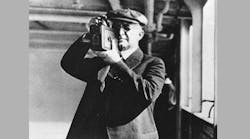Eastman Kodak, the century-old company that brought photography to the masses, filed for bankruptcy early Thursday after years of failing to keep pace with the digital age.
"The board of directors and the entire senior management team unanimously believe that this is a necessary step and the right thing to do for the future of Kodak," CEO Antonio Perez said in a statement.
"Our goal is to maximize value for stakeholders, including our employees, retirees, creditors and pension trustees. We are also committed to working with our valued customers."
The company said it has sufficient liquidity to continue operating normally and paying employees during the Chapter 11 bankruptcy process. Its foreign subsidiaries are not subject to the proceedings, it added.
The Rochester, N.Y.-based company, which dates back to the 1880s, led the way in popularizing the cameras, slide projectors and home videos that preserved the memories of generations of Americans.
But it has struggled in the age of digital cameras, and years of poor performance already had forced it to lay off 47,000 employees and close 13 manufacturing plants and some 130 processing labs since 2003.
"Now we must complete the transformation by further addressing our cost structure and effectively monetizing non-core IP [intellectual-property] assets," Perez said.
"We look forward to working with our stakeholders to emerge a lean, world-class, digital imaging and materials science company."
The bankruptcy filing places the jobs of Kodak's 19,000 remaining employees in question. At its height in the 1980s, it had 145,000 workers.
Earlier this month, the New York Stock Exchange told Kodak -- once one of the fabled 30 Dow Jones blue chips -- that it faced delisting from the exchange if it could not get its stock price back above $1 per share.
It was dropped from the prestigious Dow Jones Industrial Average of 30 top U.S. companies in 2004.
In its heyday, Kodak shares topped $80 in 1996 -- just at the outset of the digital photo revolution that eventually freed consumers from the need to buy Kodak film, once a virtual monopoly in the U.S. market.
In the Red for Years
Kodak's books have been awash with red ink for years. The last time it reported a net profit was a small gain in 2007.
Officially established by inventor George Eastman in 1892, Kodak developed handheld "Brownie" cameras that were sold at popular prices and furnished the film that would keep consumers pumping profits into the company for decades.
Three generations of Americans and many in other countries learned to snap their own pictures with Brownies, at a time when the company was lauded as one of the top U.S. innovators -- the Apple or Google of its time.
And "Kodak Moment" -- the company's advertising catchphrase for its film -- has been embedded deep in the American vernacular.
NASA lunar orbiters in the 1960s brought back some of the earliest images of the moon's surface on Kodak film, and the first astronauts to walk on the moon documented their historic expedition with a shoebox-size Kodak camera.
Kodak also furnished the film for countless Hollywood movies, including 80 Oscar-winning Best Pictures, according to the firm's website, which said it has won nine Academy Awards of its own for scientific and technical excellence.
The company pioneered research into digital photography beginning in the mid 1970s. But it was Asian manufacturers that stole a march in that market in the 1990s as Kodak failed to see the need to break from its old business lines.
In September, Kodak hired the law firm Jones Day as advisers for restructuring, though many analysts noted at the time that the firm also advises bankruptcies.
During Perez's six-year tenure as CEO, the former senior Hewlett-Packard executive sought to shore up Kodak's finances by selling off some of its huge portfolio of patents and developing its printer line.
The current plan calls for restructuring the company with the aid of a $950 million credit facility from Citigroup in order to emerge in a more competitive position at some point in 2013.
Copyright Agence France-Presse, 2011




